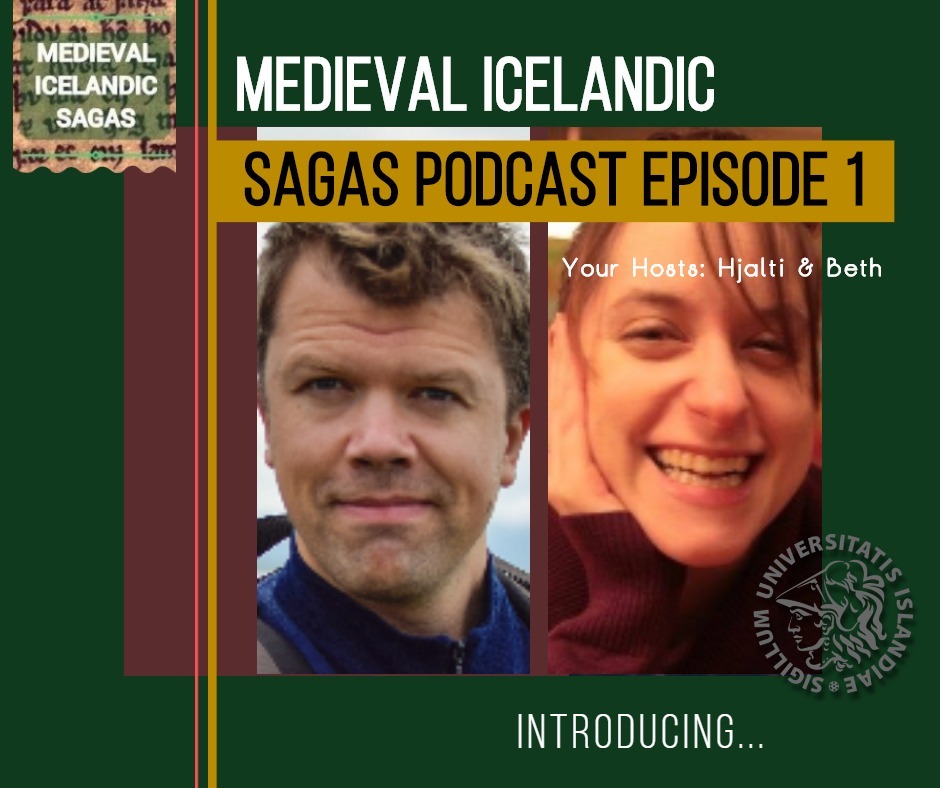
Medieval Icelandic Sagas Podcast #1
The first podcast of the Medieval Icelandic Sagas course hosted by edX and
21:42 - What the word "Viking" actually means
25:45 - A note from Hjalti about grading
27:05 - What's coming up in Week 2
29:24 - Next week's guest
29:50 - Bonus clip: Beth and Hjalti discuss advice for anyone wishing to study medieval or Norse studies
Notable scholars from the broadcast:
Andrea Maraschi, "Sympathy for the Lord: The Host and Elements of Sympathetic Magic in Late Medieval Exempla"
Notable Nordic literature or lore:
1. Beth mentions that in a certain saga, there is an account of Gizurr, a prominent goði, hiding from political enemies in a vat of
2. Beth comments also on ideas of "uncivilized" or "barbarian" tribes who drink milk. Massimo Montanari notes, "The modes of production and cultural values of the "barbarians‟ [Celtic and Germanic populations] – as the Greeks and Romans called them – were entirely different. ... Instead of wine (known only in areas bordering the empire), they drank mare's milk and its acidic liquid derivatives, or cider (made by fermenting wild fruits), or beer in those areas where grains were grown in small plots carved out of the forest."
Massimo Montanari, The Culture of Food, trans. Carl Ipsen (Oxford: Blackwell, 1994), 6-7.
3. There is a short audio clip of The Vikings (1958) trailer within the podcast. You can view the trailer on YouTube in its entirety for a gem of a production from the Golden Age of Hollywood.
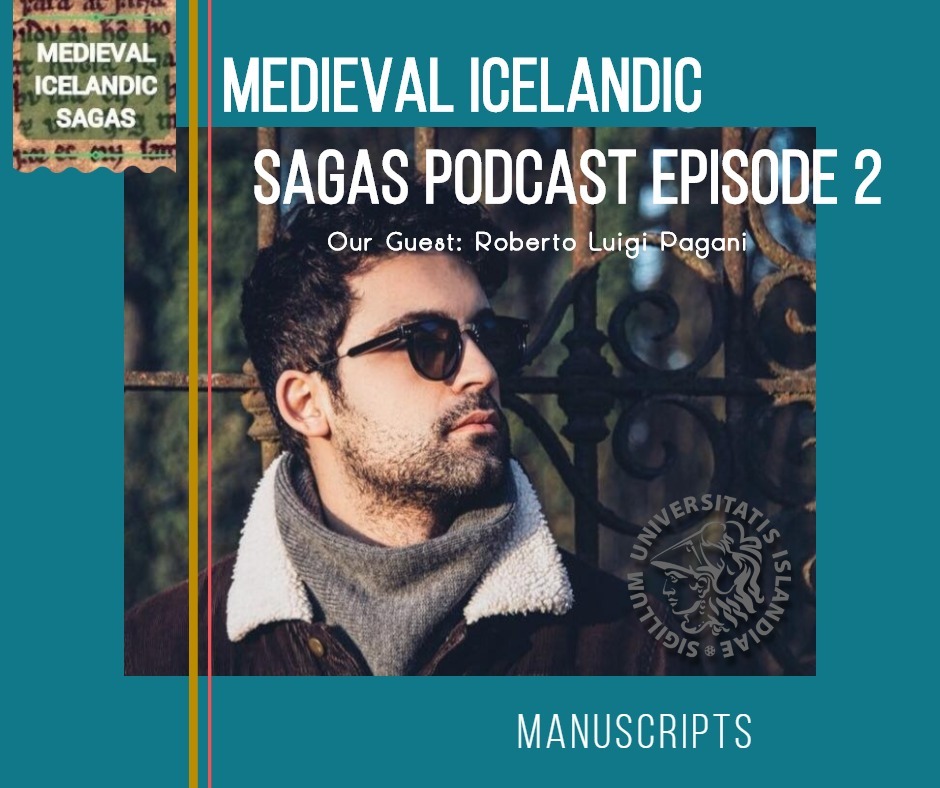
Medieval Icelandic Sagas Podcast #2
23:10 - How Vellum is Made
34:37 - Is Rob surrounded by manuscripts every day?
36:28 - Hjalti's Thoughts about the Icelandic Manuscript Return (1977-1997)
40:20 - The Manuscript Summer Course at University of Iceland
44:30 - Some Class Matters & Student Questions
47:30 - Special Thanks
48:10 - Rob's Fun Being Discussion Moderator
52.28 - Next Week's Course Theme (Landscape & Architecture)
54:41 - Next Week's Podcast Guests
Notable references to Icelandic literature or culture
1. Be sure to watch Making Manuscripts and The Structure of a Manuscript to understand how manuscripts are constructed.
2. Rob and Hjalti discuss manuscripts stored in turf houses and how the close, poorly ventilated homes may have contributed to the yellowing of manuscript pages in Iceland.
3. Hjalti and Rob discuss the difference between Icelandic and European manuscripts. Rob comments that European manuscripts are sometimes so finely made that they can look artificial. What do you think?
4. Hjalti mentions that Icelandic vellum may have been treated using the geothermal heat of Iceland. Iceland is famous for its geothermal energy and commitment to helping the environment.
5. Rob regularly attends the Manuscript Summer School. Check this link if you would like to learn more or are interested in applying!
6. Rob mentioned the Codex Runicus when speaking of rare manuscripts which involve runes. Click the link to read more!

Medieval Icelandic Sagas Podcast Episode #3
PART I: THEODÓR HANSSON
0:00 - Welcome & On this Episode
0:48 - Our Hometowns (Landscape & Archaeology)
3:34 - The South Coast of Iceland and Theo's Work as a Game of Thrones Tour Guide
5:10 - Theo's Research Interests
7:10 - Reconstructing Viking Age Fighting Styles & Combat
13:36 - The Remmugýygur Reenactment Group
16:40 - Adaptations for Modern Day "Historical Accuracy" (How do you make it work?)
20:27 - Becoming a Full Member of Remmugýygur, or "Earning Your Axe"
23:25 - Going a-Viking All Summer (Viking Markets Abroad)
24:45 - The Iceland Viking Festival
28:20 - Theo's Advice for Someone Who Wants to Take Part in Reenactment
31:32 - 34:47- Intermission
PART II: CHELSEA GRACE
34:50 - Welcome to Chelsea & Her Hometown
35:50 - Chelsea's Studies
36:05 - Chelsea's Experiences in Remmugýygur
37:40 - How to Get Started as a Viking Fighter
38:45 - Making Decisions about Clothing and Historical Accuracy
42:30 - Fighting Practice and the Sporting Aspect of Reenactment
44:45 - What Being a Part of Remmugýygur Means to Chelsea
49:23 - Food History Moment!
54:00 - Chelsea's Advice for Someone Who Wants to Take Part in Reenactment
54:45 - Course Matters
57:55 - Next Week's Guests
1:00:00 - Special Announcement
Theo has a Facebook page where he talks about his career as a Game of Thrones tour guide and also as a frequent movie extra and background actor in films and TV shows that shoot in Iceland. Join if you want to get to know this amazing guy and see fun photos of him in his Viking kit, working with the community.
In talking about his family farm, Theo mentions that it is near Eyjafjallajökull, the volcano which erupted in February 2010 and caused havoc around the world as tons of ash spewed into the skies and stopped air traffic all over Europe.
Both Theo and Chelsea mention William R. Short‘s book, Viking Weapons and Combat Techniques, as an important source for a historical understanding of fighting techniques in the Viking Age.
Theo comments that he is a member of the current school of thought in Iceland regarding the veracity of the sagas, in which Bookprosist thinkers believe that the sagas are purely works of literature or fiction. The opposite school of thought is called Freeprosist and was more popular until the mid-20th century. Freeprosists believe that the sagas are historical fact based on an earlier oral tradition and do not take into account the fact that the sagas were written hundreds of years after the events they depict.
As Jesse Byock explains, "Saga scholarship during the past half-century has tried to pry the sagas loose from their traditional social moorings in order to raise the status of these tales from bits and pieces of folklore and history to the realm of great literature. This effort was led by scholars who became known as ´
Theo describes much of his inspiration and information about fighting style in the Viking Age, which comes from not only textual descriptions but images
Theo also mentions HEMA, Historical European Martial Arts, which you can read more about on their homepage.
Theo discusses the Viking Market that will take place this summer, 14-17 June 2018. An estimated 130 +/- Viking reenactors and craftsmen will take part, both members of Rimmugýgur and other Viking groups, to Viðistaðatun park in Hafnarfjörður.
Theo also mentioned the former home of the Viking Market, Fjörukráin, the Viking Hotel. We at edX and University of Iceland have no connection to the
Hjalti‘s mother occasionally appears at our local Viking festival to celebrate her skills in tablet weaving with likeminded members of the community. Tablet weaving is a handicraft that produces bands or ribbons of material. The Viking reenactors of the Rimmugýgur group use these to decorate the hems and collars of their Viking clothing.
Both Chelsea and Theo have experienced the Viking summer festivals at Mosegaard and Trelleborg in Denmark. Find more photos of the Mosegaard festival here.
The main Viking festivals in the Nordic countries during the summer season are:
Viking Moot and Festival, Reykjavik, Iceland (14-17 June 2018) - Link goes to a blog post about the 2017 festival
Mosegaard Viking Moot Mosegaard, Denmark
Trelleborg Viking Festival Trelleborg, Denmark
Wolin Festival of Slavs and Vikings, Wolin, Poland
Theo also mentioned the difference between Eastern style and Western style sword-and-shield fighting. In the two linked YouTube videos, the Eastern style fighting (where no
Theo and Chelsea spoke of Rimmugýgur having its own emblem on their shields and an “axe” necklace that full members must earn. Many reenactment groups have an identifying piece of
Chelsea has a laugh about the Rimmugýgur fighting practice being in a parking garage, like Fight Club, for much of the year when the weather is too cold to be outside. Some of this footage is on YouTube and you can see for yourself. Just remember the First Rule of Fight Club. J
Chelsea mentions historical accuracy as far as the
For those interested in learning more about Viking clothing, Chelsea also recommends Viking Clothing by Thor Ewing.
Chelsea and Beth discuss being too short for the Dane axe. This is a Dane axe, for those unaware of the size! (A Dane axe is approximately 2 meters, which is 6 and a half feet tall!)
Beth makes a joke that the Viking fighting is like Lindisfarne, referencing a Viking raid in 793 on a monastery on the island of Lindisfarne off the British coast. It sent shockwaves throughout the Christian Western world and is usually considered the beginning of the Viking Age.
Pictures of Vikings and re-enactment come from the Facebook page of the group Rimmugýgur (Used with permission). See more photos here.
** Jesse L. Byock, Feud in the Icelandic Saga (Berkeley: University of California Press, 1993), 7.
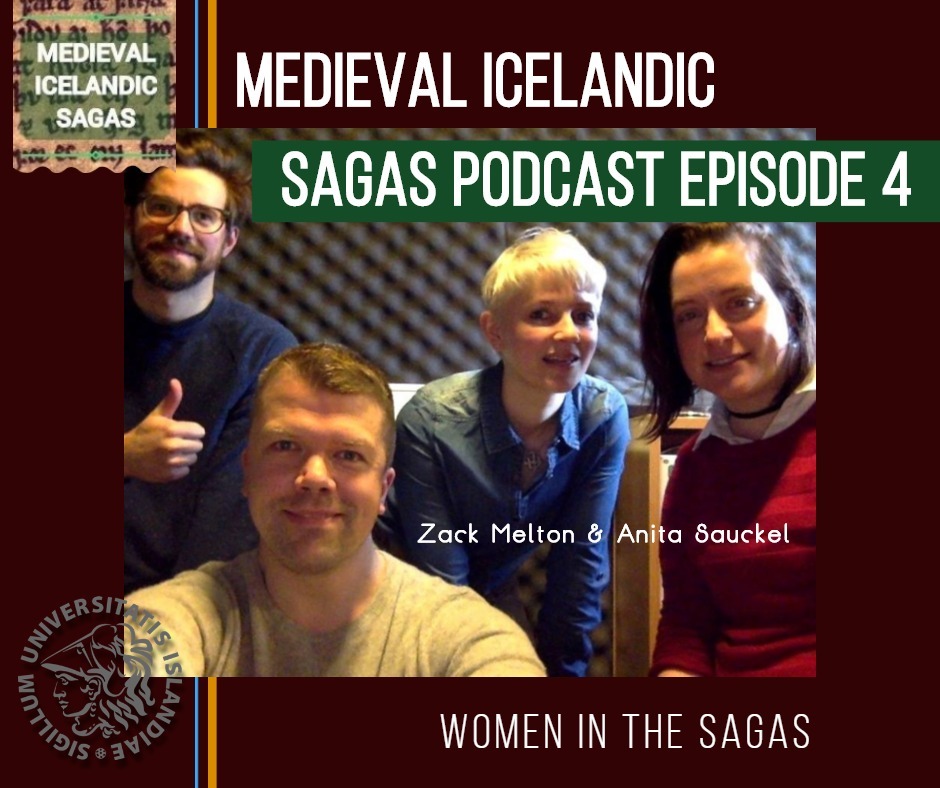
Hjalti‘s
Hjalti mentions a scene in Eiriks saga rauða in which we get a really good (rare) description of a pagan ritual done by a woman called the litlavölva. Read it in Chapter 4 here. This is the only scene in a saga which apparently passes the Bechdel test!
The queen lays a curse on Hrut: "You will not have sexual pleasure with the woman you plan to marry in Iceland, though you'll be able to have your will with other women. Neither of us comes out of this
Later in the story, his now-wife, Unnr asks for a divorce:
Svo mun vera verða," segir hún. "Eg vildi segja skilið við Hrút og má eg segja þér hverja sök eg má helst gefa honum. Hann má ekki hjúskaparfar eiga við mig svo að eg megi njóta hans en hann er að allri náttúru sinn annarri sem hinir vöskustu menn."
"Hversu má svo vera?" segir Mörður, "og seg mér enn gerr."
Hún svarar: "Þegar hann kemur við mig þá er hörund hans svo mikið að hann má ekki eftirlæti hafa við mig en þó höfum við bæði breytni til þess á alla vega að við mættum njótast en það verður ekki. En þó áður við skiljum sýnir hann það af sér að hann er í æði sínu rétt sem aðrir menn."
"I want to divorce Hrut, and I can tell you what my main charge against him is - he is not able to have sexual intercourse in a way that gives me pleasure, though
"How can that be?" said Mord. "Give us more details."
She answered, "When he comes close to me, his penis is so large that he can't have any satisfaction from me, and yet we've both tried every possible way to enjoy each other, but nothing works. By the time we part, however, he shows that he's just like other men.”
Obviously, there is a lot to explore about women and gender issues in scenes such as this!
To explore the idea of Icelandic men who the ladies abroad can’t resist, I present you with hot Icelandic men, sexy Icelandic dads, and the more general 24 Scandinavian Men Who Have Ruined All Other Men. (Sure, Hjalti! It’s just a literary trope!) J
To learn more about Anita’s book on textiles in the sagas and in archaeological finds, see the link here.
Anita mentions the Woman in Blue, a startling find in women’s graves and in textiles. More about the exhibition from Iceland Magazine.
Anita discusses
For example, in this edition of the story:
1. Hallgerður is wearing dark blue in Chapter 13 when she meets her second husband (and we all know how that turned out)
2. Thráin is described as always riding out in a blue cloak in Chapter 90 when he becomes a primary antagonist of the Njálssons
3. Skarphéðinn is wearing a blue cape in the next chapter (91) when he and his brothers go to take vengeance on Thráin’s entourage – this is the example Hjalti explains
4. Njál is wearing a blue cape in Chapter 117 when he goes to speak to his sons about the disastrous course they are on.
Bernard of Clairvaux, in fact, wrote a whopping 85 sermons about the Song of Songs Bible verses (also known as the Song of Solomon)
Here is the advert for Anita’s first handicrafts class on spinning:
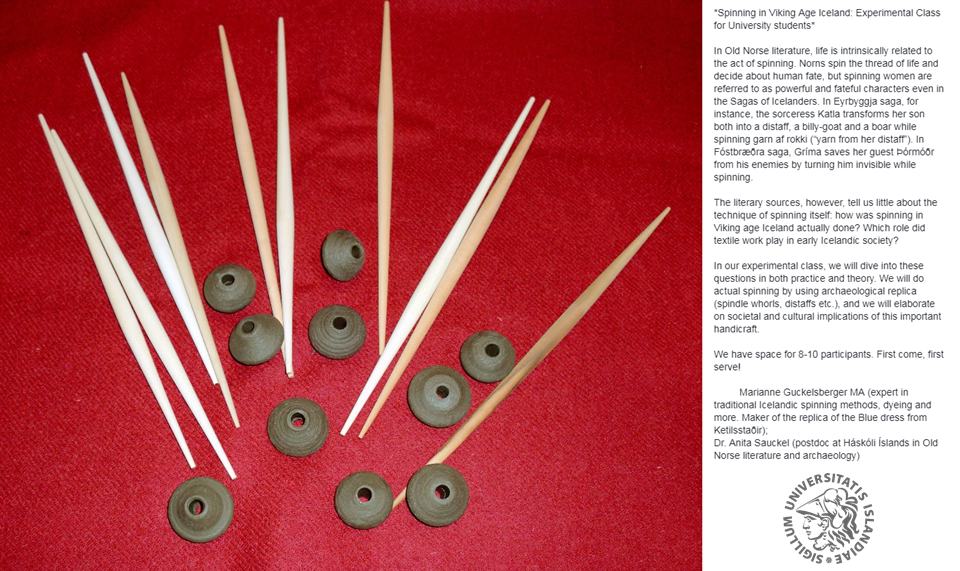
Anita mentions Eyrbyggja saga’s descriptions of Katla, the witch whose powers are seen in her weaving. In Chapter 18 of the edition here, Katla gives her son Odd a new brown kirtle she has made, and during the battle which happens shortly after (it’s a saga; of course there is a battle), “no weapons would bite on Odd Katlason.”
In Chapter 20, the connection is made even more explicit when a band of men come looking for her son Odd for vengeance. Katla tells him to sit near her while she spins. While she is doing so, the men cannot see Odd sitting beside her.
In discussing Needlebinding, a historical method of knitting, Anita and Hjalti mention that there is an example of this kind of textile making (in the form of a mitten) at the National Museum of Iceland.
Erika Ruth Sigurdson has also written an exploration of the use of phrases like “rape and pillage” in popular culture representations of the Vikings. (Requires university access to get the full article)
Zack mentions that he was first inspired to learn more about Vikings and reception theory in 19th century America by Ralph Waldo Emerson. He delved more deeply into these representations in his MA thesis, which you can take a closer look at.
Zack discusses Jenny Jochens‘ work, “The Illicit Love Visit: An Archaeology of Old Norse Sexuality”
Zack also mentions Carl Christian Rafn and his 1837 work Antiquitates Americanae. It is considered the first scholarly exposition of the Pre-Columbian Norse exploration.
Another of Zack’s book recommendations: Annette Kolodny’s In Search of First Contact: The Vikings of Vinland, the Peoples of the Dawnland, and the Anglo-American Anxiety of Discovery
The Woman’s Bible by a committee of 26 women led by Elizabeth Cady Stanton (#patriarchy)
The Lay of Sigurdrífa is one of the most well-known Eddic poems and tells of the plight of the character Sigurdrífa, who is known as Brynhildur (Beth’s
Recently, Harper’s magazine ran a piece called “The Rise of the Valkyries,” tying ideas of women’s empowerment from the 19th century to modern ideals of the alt-right.
Finally, the popular Icelandic metal band Skálmöld has an alum called Baldur which is very saga-
Medieval Icelandic Sagas Podcast Episode #5
1:37 - Our Guests, Sigurboði Grétarsson & Snæbjörn Ragnarsson (a.k.a. Bibbi)
5:00 - Life in a Small Town (I Know You, But I Never Met You)
6:40 - How Many Instruments Do You Play?
10:58 - Skálmöld: A Name, A Band, and a Concept
15:30 - Gladiator Rock and Roman Metal (Why is this not a thing?)
17:45 - Sigurboði is Chill (Music Genres and Categorization)
20:10 - Music Festivals and the Metal Scene in Iceland
25:25 - The Question of Accuracy
30:30 - Getting Down to One Version (Christianity)
34:40 - The Ásatrú of Iceland
38:00 - Ásaboo and the (Not Really) Viking Hordes
40:10 - The (Real) Vikings Go East
41:10 - Bibbi is a Terrible Poet and He Knows It
45:47 - Sigurboði Performs "Norskt runaljóð"
52:00 - What Do You Want Your Listeners to Experience?
54:18 - Week 6 and Upcoming Podcast Guests
Gisli Sigurðsson kindly lent us his office for recording this episode, which is why it has a different sound quality. Gisli is a research professor at the Árni Magnússon Institute and specializes in folklore, so you can imagine that his office is cram-jam with interesting things!
Harpa Conference Center and Concert Hall is this unique-looking building which hosts a number of different shows, bands, orchestral performances and more throughout the year.
Músiktilraunir is the Icelandic version of the “Battle of the Bands,” where new bands and musicians come to refine their performances. Learn more about the Icelandic Music Experiences here.
Bibbi, also known as Snæbjörn Ragnarsson, is from Húsavík, the Whale Watching Capital of Iceland in the north of the country.
In case you missed it because Beth was laughing, Bibbi‘s recreational band is called The Ugly Idiots (in Icelandic). #goals
The instruments which are Sigurboði‘s top 3 are:
- Lyre
- Bouzouki
- Guitar
Bræður
hart er í
hórdómur
skeggöld, skálmöld,
vindöld, vargöld,
áður veröld
mun
öðrum þyrma.
English translation:
Brothers shall fight
and fell each other,
And sisters' sons
shall kinship stain;
Hard is it on earth,
with mighty adultery (fornication);
Axe-time, sword-time
shields are sundered,
Wind-time, wolf-time,
ere the world falls;
Nor ever shall men
each other spare.
The name Skálmöld also refers the Age of the Sturlungs in Icelandic history, when a civil war broke out between the country's family clans. Obviously, this was also a time of chaos and bloodshed compared to the relative peace that reigned before.
Sigurboði mentions being inspired by the music of Bön monks. You can read more about the ancient religion of Tibet here.
Sigurboði’s album is on Spotify as Niðafjöll. Check it out if you are in the mood for some “Symphonic pagan metal.” ;)
Eistnaflug is a metal festival in Iceland that has taken place annually since the summer of 2005. Eistnaflug is an indoor festival situated in Neskaupstaður, a quaint little town located on the Norðfjörður fjord on the Eastern coast of Iceland, 700 km away from Reykjavik.
Beth mentions that heavy metal as a music genre may have different connotations based on where you are in the world. In the 1980s, for example, there were many groups in America who rushed to blame the popularity of this genre for various social ills at the time. You can learn more about this in Kieran Fisher’s article, “Satanic Panic: America’s War on Heavy Metal in the 1980s”
Bibbi mentions that Skálmöld did a full concert with the Icelandic Symphony Orchestra, an indication of how widely accepted and known heavy metal is in Iceland and Scandinavia. Watch it here.
Bibbi describes how he adapts Norse mythology, like the poem Hymskviða, about Thor going fishing for the mighty World Serpent Jörmungandr into some of his songs.
As we mentioned in our course in Week 5, there have been many different gods and goddesses celebrated for different reasons in Scandinavia and perhaps Óðinn was not the
When discussing the Ásatrúarfélagið, the Icelandic religious association of Heathenry, Sigurboði discusses the first goði (here, meaning priest). The organization was led by farmer and poet Sveinbjörn Beinteinsson from 1972 until his death in 1993. During most of this period membership did not exceed 100 people and after the initial enthusiasm faded, there was little activity, but that has changed today with renewed interest in pre-Christian beliefs.
Obviously, there are many opinions out there when it comes to religion and spirituality. Sigurboði mentions the idea of “atheist pagans.” Here is just one opinion piece online which discusses this idea; feel free to look further into it if you would like to know more.
Sigurboði introduces Beth and Hjalti to the very funny term “Ásaboo,” a variation on the internet slang, “Weeaboo,” which is a derogatory term for a non-Japanese person who immerses themselves in Japanese culture to the exclusion of other things. As Sigurboði said, sometimes people become very excited by Viking Age and medieval Scandinavian culture and buy themselves
The group discusses the Viking expansion into Byzantium and Greece, which refers generally to the Kievan Rus’ (though some scholars consider this group to be Swedish/Germanic in origin, and thus Scandinavian, some scholars from Russian areas assert that they are not!) As Beth mentions, runic inscriptions (graffiti) have been found in the Hagia Sofia, a church (then a mosque and now a museum in the present day) constructed in Constantinople in 537 AD.
Another hot topic as far as Vikings in the East is the
Sigurboði's lyre is designed after an archaeological find from Trossingen in Germany. This is
Sigurboði sings a song called “Norskt runaljóð” about Óðinn’s quest to acquire the knowledge of runes. Here is more about runic alphabets and this poem (Icelandic language; use a translator like Google Translate to help you)
Sigurboði’s song is also available on YouTube, with soothing and interesting graphics to accompany the music.
In an awesome crossover event, here is Sigurboði singing Skálmöld’s song “Baldur,” accompanied once more by the lyre. 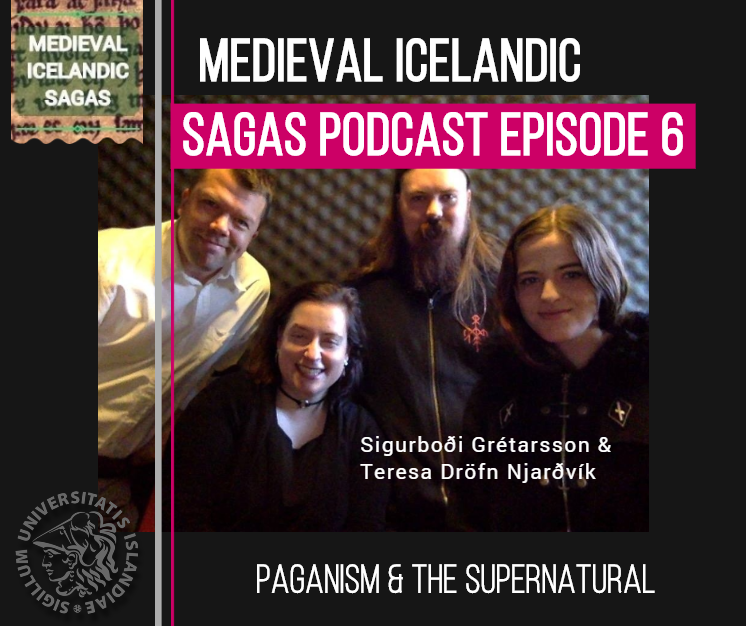
Medieval Icelandic Sagas Podcast Episode #6
0:00 – Hello & welcome
0:25 – What‘s
1:16 – Life in a Northern Town
8:16 – Teresa‘s Research at the Árni Magnússon Institute
13:30 – Sigurboði‘s Experience with Spiritual Leaders
20:15 – More on Teresa‘s Book, Runes: The Icelandic Book of Futhark
23:00 – The Supernatural Power of the Runes (Magical Thinking)
30:12 – When Runes Go Wrong (Egils saga)
32:47 – Runes and Christianity (“Haraldr made this stone”)
37:20 – Wait, there are more runic alphabets than the younger and elder futhark?
38:20 - Runeology is a neglected field (Come to Iceland, scholars!)
38:50 – Do 50% of Icelanders believe in elves? (Everyone rolls their eyes)
42:50 – Damn house elves stole my keys!
44:15 – Supernatural creatures and their strange evolution in pop culture
45:17 – Have Teresa and Sigurboði seen an elf? (Hjalti has a story!)
49:25 – The Icelandic Association of Heathenism (Ásatrúfélagið)
52:00 – Who is allowed to be a pagan? (Hint: Everyone)
54:40 – Living in a Box
57:00 – Advice for Those
59:40 – One More Podcast
At the beginning of the podcast, everyone shares stories about home. 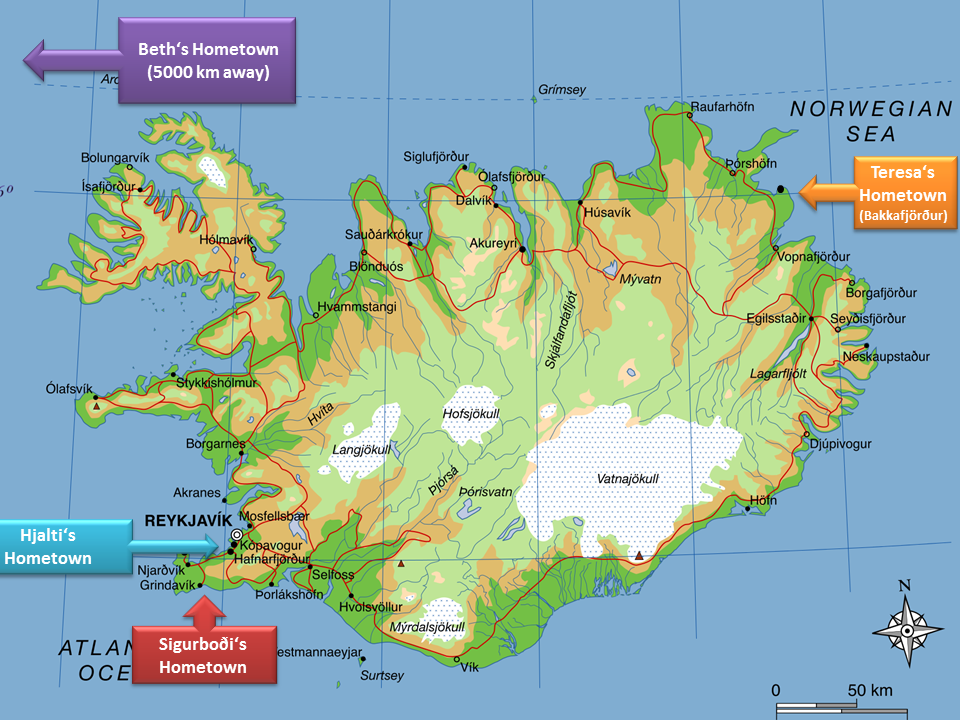
Jokes about people from Hafnarfjörður are fun entertainment for people in Iceland, much like blonde jokes elsewhere in the world. Read more about this phenomenon here.
Beth’s
Q: How did the guy from Harfnarfjörður drown in a submarine?
A: He opened the window to get some air!
Teresa recommends that everyone planning to visit Iceland check out our very own Henge! (It‘s actually in Raufarhöfn, but that‘s very close to her hometown of Bakkafjörður!)
Teresa mentions confusing her new
Teresa and Hjalti discuss her work with rímur, which we have learned about from Matthew Driscoll in Week 2. For those interested in hearing more from this scholar, here is a 2013 interview he did at the University of Copenhagen, again on his own research on rímur.
Teresa mentions that rímur are like TV shows with their openings and endings (“Previously on this episode…” and “In the next rímur, the hero will do this…”) You can read examples of rímur and their style in this MA thesis by Hannah R.F. Hethmon, available on the University of Iceland open access portal, Skemman.is
Teresa‘s book is called Runes: The Icelandic Book of Futhark (English language)
When speaking of the discovery of the runes in the Eddic poem Hávámál, Sigurboði quotes the following verse:
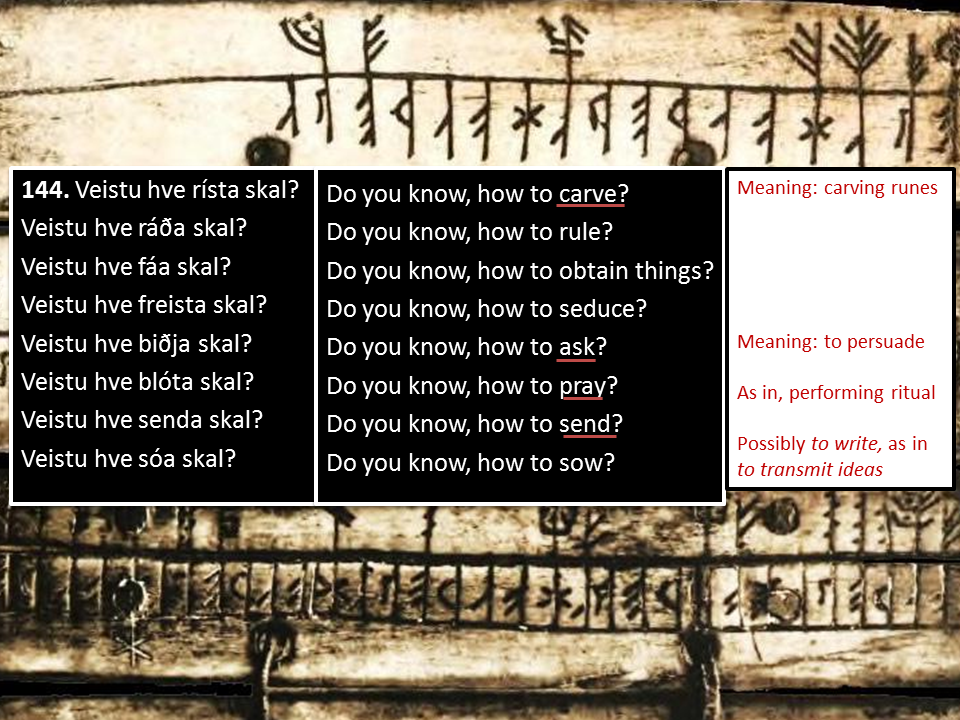
Here is what this verse looks like when written in runes!
When Teresa describes Tyr and how he became the one-armed god, she is retelling the story of The Binding of Fenrir. Perhaps in reference to this story, the later runic alphabet shows the T rune with only one arm. (Check out my awesome art, everyone!)

Teresa also mentions a rune called Berkanan and its strange association with Loki (See the Old Norwegian version of the verse here). However, when one considers that possibly the rune is meant to represent a pregnant woman, the connection becomes more clear. In Norse mythology, Loki is known to take female form occasionally, and in the form of a mare, he gave birth to
Teresa discusses a scene in Egils saga where a woman is sick and the hero, Egil, finds “dark runes” in her sickbed which are keeping her from healing. You can read this Chapter online (Chapter 75).
Theresa mentions

From left to right: the mark of the Icelander Ormur Ketilsson (1369), the mark of the Icelander Þórður Snorrason (1439) the mark of the Swedish court judge
Teresa and Sigurboði comment that the Icelandic runes are similar to the younger futhark (fuþark).
Teresa describes “magical thinking,” as what gives runes their power – if you believe they are powerful, then they are. To learn more about this concept, try:
Magic, Science and Religion and Other Essays by Bronislaw Malinowski
“Finding Folk Religion: An Archaeology of ‘Strange’ Behaviour” by Sonja Hukantaival (full text)
Beth mentioned seeing trivia on her arrival in Iceland which claimed 50% of Icelanders believe in elves (or fairies, as the media sometimes calls them)!
Whatever the people may believe, Iceland has made a few major decisions based on where the elves may be living.
Be careful: The elves that take your car keys and hide them from time to time are known as Búálfar, a house elf with a mischievous nature.
Teresa tells the story of Ólaf Geirstaða Álfr, where King Ólafr of Norway (not the same Ólaf who brought Christianity to Iceland!) died from an illness (either gout or an attack of the plague). After his death, he was worshipped as an elf; offerings were made at his burial site for good luck. Most scholars do not take this interpretation to mean that the king became a literal
Teresa also does this by thinking of her departed father as a “land spirit” or “elf,” which helps her feel close to her father and also helps her daughter feel connected to the grandfather who passed away when she was just 3 months old.
Teresa and Sigurboði both happen to be members of the Ásatrúfélagið in Iceland (although, as they say, one does not have to be a member of a group in order to practice the pagan or heathen faith).
Theresa says you don’t have to follow “rules” as a heathen, such as wearing your
Sigurboði recommends reading the Eddas to know more about Norse pagan or heathen ideas and stories. There are 2
For English speakers, he suggests Neil Gaiman’s book Norse Mythology. Teresa recommends Old Norse Religion in Long-Term Perspectives: Origins, Changes & Interactions by Anders Andrén and Kristina Jennbert (eds.)

Medieval Icelandic Sagas Podcast Episode #7
0:00 – What‘s
1:00 – Haraldur‘s background and research interests
7:30 – Haraldur‘s advice for learning Old Norse or modern Icelandic
9:30 – Reconstructed versus non-reconstructed (modern Icelandic) pronunciation
10:35 – Beth is
12:45 – Thoughts about our edX course and its success
14:55 – Programs at the University of Iceland (VMN and MIS)
18:35 – Haraldur‘s thoughts on why Norse culture is so interesting across the world
20:35 – Research projects and comparing cultures
22:10 – More about the structure of VMN and MIS
26:40 – Haraldur and the rock stars of the Árni Magnússon Institute
27:45 – A little encouragement
29:15 – How to be a good scholar
30:00 – Hjalti‘s advice
33:50 – Keep learning, everyone! (Beth‘s advice)
36:40 – Our goodbyes (and Beth‘s Icelandic gets her again!)
Haraldur tells us he grew up in Akureyri.
Haraldur is familiar with the Proto-Indo-European family of languages.
Haraldur mentions that a great way to practice modern Icelandic is to find a job or volunteer in Iceland. Read some suggestions from Lonely Planet here.
Beth tells a story about the fortune she received this year inside her Easter egg. Here‘s an example of what you find inside a páskaegg.
Once again, you can find information about the Viking and Medieval Norse Studies program and its sister program, Medieval Icelandic Studies, on the university website.
After a long discussion of what makes a good scholar and why we do this crazy, frustrating, wonderful work that we do, Beth and Hjalti and Haraldur had a laugh over this footnote.
Beth and Hjalti discuss the fact that there is so much material in Icelandic history to cover, it‘s a shame we couldn‘t find time for the Age of the Sturlungs, which is a post-medieval part of history which led to Iceland becoming a Norwegian territory and ending the Icelandic Commonwealth. (Iceland would regain its independence, this time from Denmark, in 1944.)